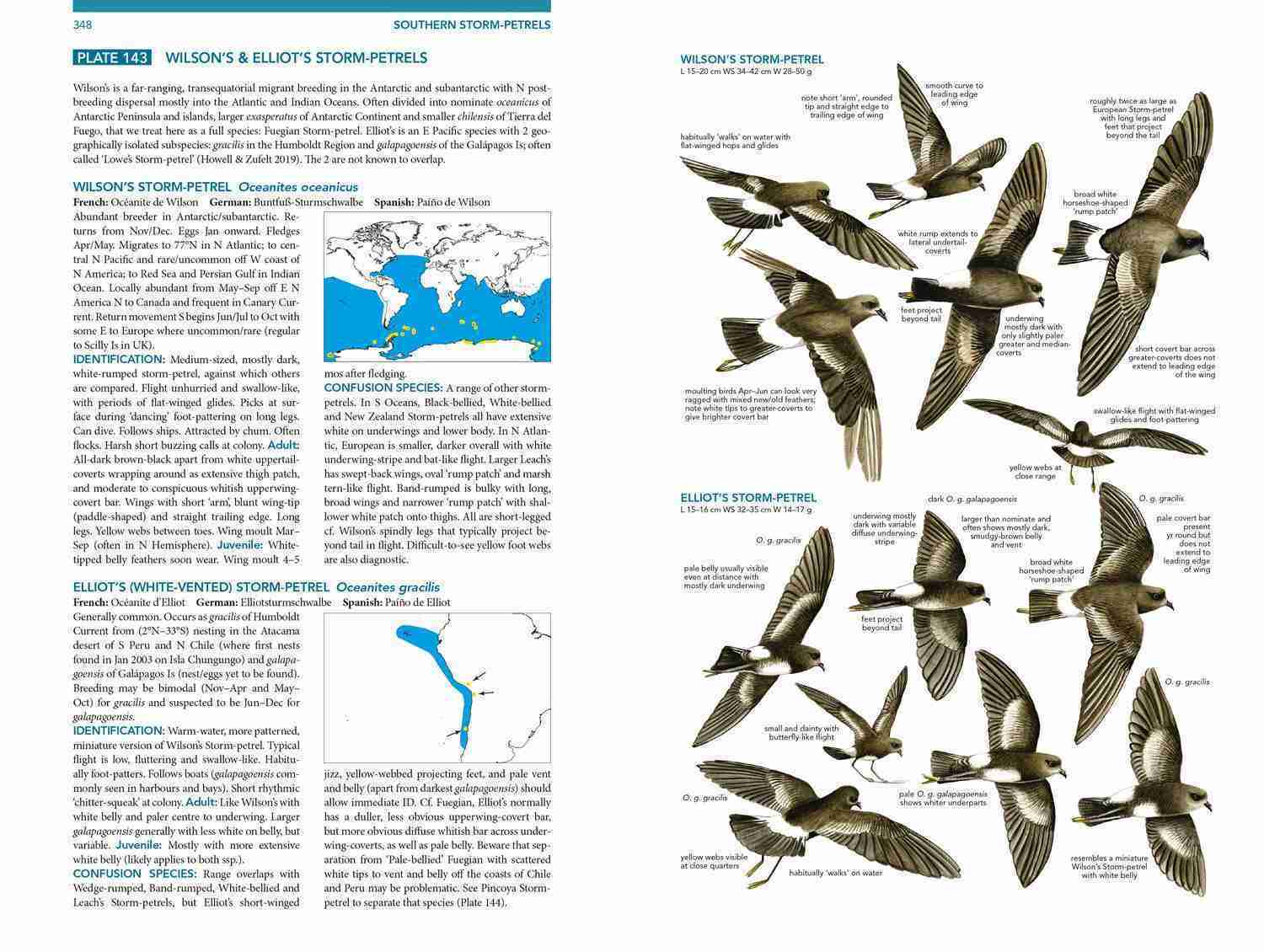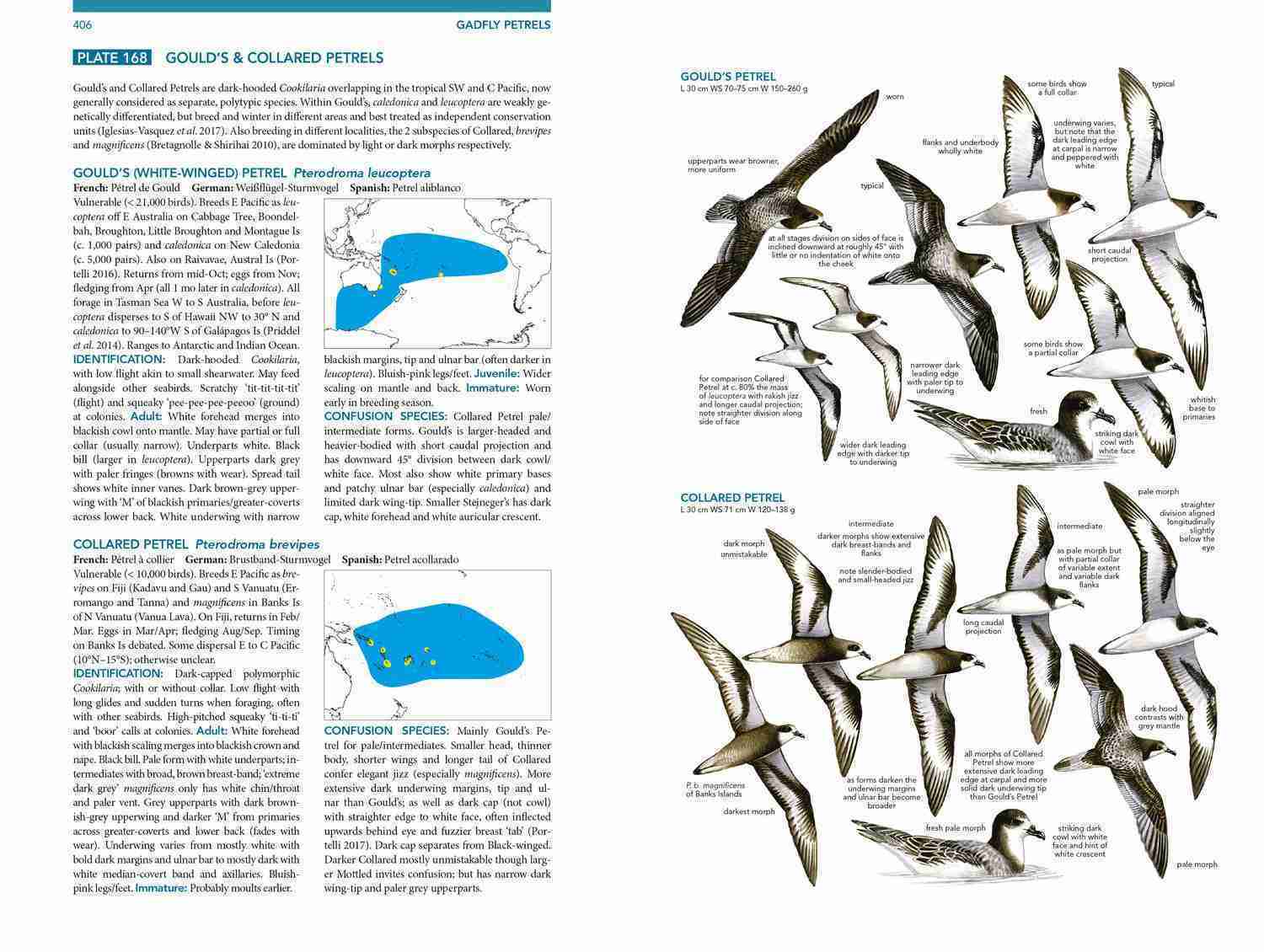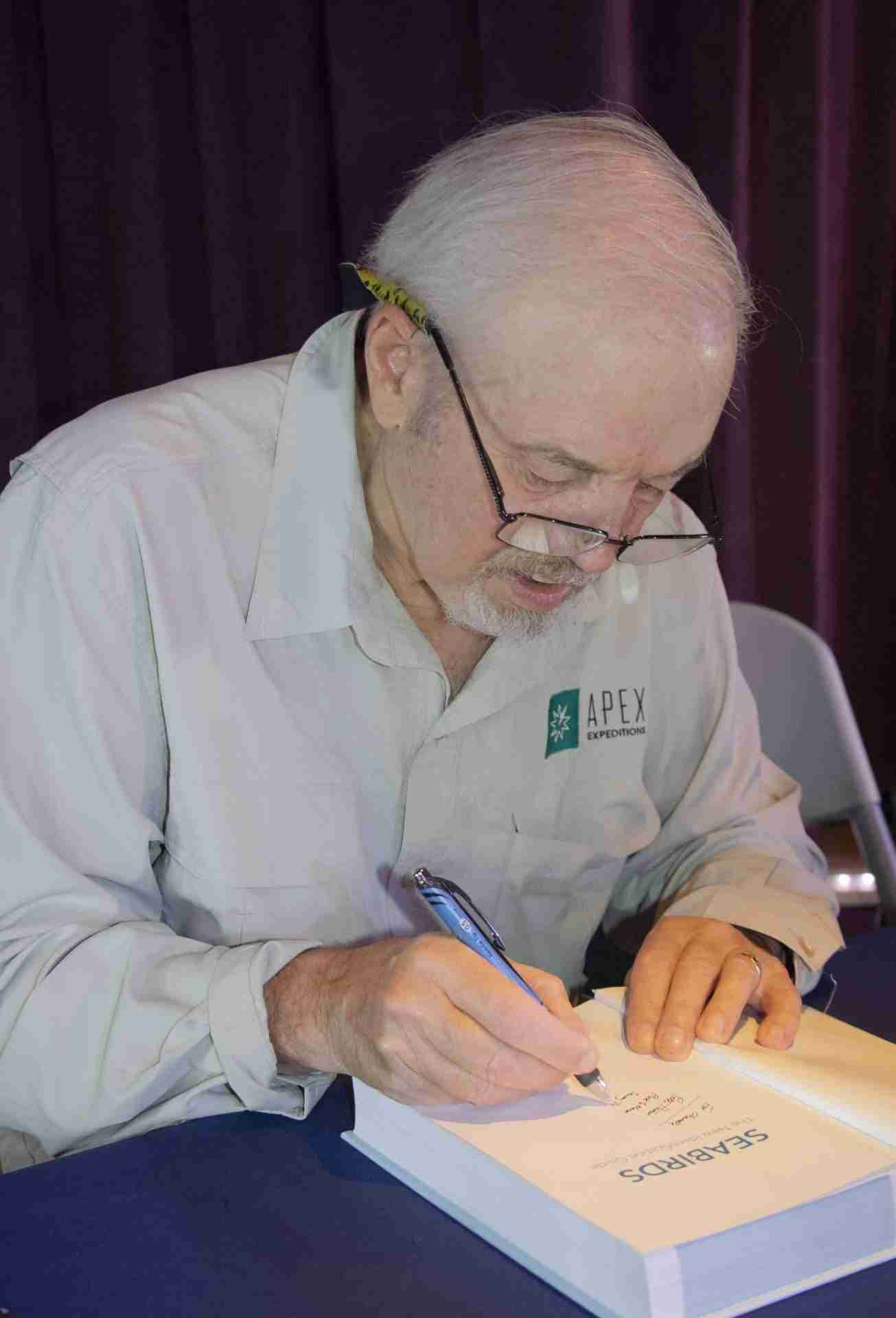SeabirdsThe New Identification Guide
75.00€
Illustrator
In stock
75.00€
Weight
1.7 kg
Size
15.6 × 23.5 cm
Pages
600
Publishing date
June 2021
Published by
Lynx Edicions
Description

This is the first comprehensive guide to the world’s 434 species of seabirds, to be published since the 1983 publication of Harrison’s Seabirds: An Identification Guide. It covers all known seabirds, beginning with seaducks and grebes and ending with cormorants and pelicans. Lavishly illustrated and detailed throughout the 600 pages, this guide gives full treatment to all known seabird species including recently rediscovered and rarely seen species.
- The essential new identification guide to the seabirds of the world.
- 239 superb, full-colour plates with extensive captions and detailed facing-plate identification texts and maps, to enable identification at a glance.
- More than 3,800 full-colour figures with illustrations of distinct subspecies, sexes, ages and morphs, are further supported by in-text identification keys and figures.
- Comprehensive and definitive, the text covers status and conservation, geographic range, movements and migration, breeding biology and feeding habits, plus identification and latest taxonomic treatments.
- The only seabird guide to cover all known seabird groups and species. Seabirders worldwide will find this to be an authoritative, one-of-a-kind publication for use around the globe.
CONSERVATION EDITION
A larger format boxed “Conservation Edition” with a global print run of just 1,000 numbered copies is also available. A portion of the proceeds from the sales of this version will be used to support seabird conservation projects around the world. Full details of the Conservation Edition can be found at www.peterharrisonseabirds.com.





























 Copyright 2025 © Lynx Nature Books
Copyright 2025 © Lynx Nature Books
Gehan de Silva Wijeyeratne –
In the early 1980s, before the current explosion of natural history books, there were two groups of birds that were particularly challenging. Namely, the waders and seabirds. A single book that would provide a comprehensive identification guide to each of all the waders and seabirds in the world seemed the stuff of fantasy. Then it all changed with the series of family monographs published by Christopher Helm. ‘Seabirds. An Identification Guide’ by Peter Harrison (1983) and ‘Shorebirds: An Identification Guide to the Waders of the World’ by Peter Hayman et. al. (1986) were ornithological milestones and paved the way for an innovative series of family monographs. They also provided a useful toolkit for professional ornithologists and recreational birders. Nearly forty years on from the original publication, the new seabird identification guide is a vastly improved offering bringing together many of the advances in field identification. With the first book, there was a sense of something complete. Perversely, the expanded current edition leaves us with a distinct sense of unease at how little is still known and how we still don’t even have a grasp of how many seabird species there are. As recent publications have demonstrated, there are cryptic species of birds sometime hidden in plain sight. But it also reminds us that at time when plans are underway for a lunar base, our own planet, imperilled as it may be by climate change, is still a world not yet fully explored. Peter Harrison has been amongst a few privileged scientific explorers who has lived a life like some sort of an ornithological Indiana Jones.
The two page preface, is an elegant synopsis of Harrison’s life and work. How he received his first binoculars at the age of ten from his father an officer in the Royal Navy, the retreating seabirds in that memorable storm which converted him to a seabirder, the seven years of working as deckhand to travel the world to observe and draw seabirds and the four years to work on the first book and the last fifteen years bringing together this new book. The preface reads like a movie script. Many committed seabirders will find it resonates with their own experiences of what drew them to seabirds and be filled with awe at the decades of dedication and adventure that has gone into the latest book. The acknowledgements make clear that many others played a crucial part in the team that made it all possible. The two other most obvious significant contributors being the second author Martin Perrow and second artist Hans Larsson. The latter is a familiar name to seabirders having contributed the illustrations to two seminal volumes on seabirds which were authored by Klaus Malling Olsen. ‘Gulls of Europe, Asia and North America’ (2004) and ‘Terns of Europe and North America’ (2005), also published by Christopher Helm were seminal works. I still hold onto my original copies of these various aforementioned books as not only are they important ornithological publishing milestones but as with many birders I see them as important waymarks in my own personal birding life.
I first began to watch seabird off the coast of Colombo after Sri Lanka’s most famous seabirder Rex de Silva enrolled me and a bunch of other eager schoolboys to help him on his multi-year study of the mass movement of Bridled Terns (Onychoprion anaethetus). By today’s standard the optics available then were basic and the identification literature spartan. With the ‘new Harrison’, I can randomly pick a page on almost any bird and not fail to be impressed by how much things have moved on in field identification.
However impressive it is, the authors also point out that this book is only another new beginning. It is not the last word on seabirds as even details as basic as species delimitations are still to be resolved using a combination of traditional morphometrics as well as new technologies such as molecular phylogenetics and acoustic analysis. I am glad that this book follows a series of important seabird books by Klaus Malling Olsen and Steve Howell et. al. (including the fairly recent ‘Oceanic Birds of the World: A Photo Guide’ published Princeton University Press in 2019). It makes it easier that taxonomic decisions, suggestions and discussions in previous books are already factored into this book. But seabird taxonomy remains in flux. A case in point is the Manx Shearwater (Puffinus puffinus) complex which was treated as a single species but was then split into Yelkouan (P. yelkouan) and Balearic (P. mauretanicus). Both Howell and Zufelt (2019) and Harrison et. al. (2021) accept the splits. But a year later, after the ‘new Harrison’, Joan Ferrer Obilo et.al. published a paper (‘Species delimitation using genomic data to resolve taxonomic uncertainties in a speciation continuum of pelagic seabirds’) which challenged this. Obilo et.al. found no support for Yelkouan and Balearic to be separate species and proposed relegating them to sub-species status. Both the ‘new Harrison’ and the ‘Howell and Zufelt’ flag many instances where the taxonomy of species complexes remain resolved. It may take several years or possibly decades for seabird taxonomy to stabilise in spite of the advances being made in whole genome sequencing technology. It is also difficult to study some of these seabirds found on remote oceanic islands making it hard to accumulate the behavioural and acoustic analyses to complement DNA analyses.
Many of us, will never have the time and the money to go in pursuit of some of the enigmatic and little known seabird species. However, this is not to say discoveries cannot be made closer to home. My seabird watching is primarily in the UK and Sri Lanka, coupled with opportunistic sea watching on trips abroad. In April 2012 I wrote an article that the sea off the Kalpitiya Peninsula (between E79 38 and E79 35) in Sri Lanka was one of the best places in Asia to see rarely seen pelagic seabirds. In my search for Blue Whales and Sperm Whales I had accidentaly discovered that certain species which were considered very rare in the Indian Ocean around India and Sri Lanka were occurring in good numbers, if only you knew where to look and when. A few years later at the Uttar Pradesh Bird Fair in 2016, I was flattered to hear from Praveen J that my articles had inspired him and other Indian birders to charter sea-going boats. On their pelagic trips they had remarkable seabird encounters and they published papers in Indian Birds, the Journal of South Asian Ornithology. Going out to sea is an expensive business anywhere in the world and very few can afford to charter boats. It is often the development of a local whale watching or dolphin watching industry that facilitates an affordable infrastructure for pelagic seabird watching. Books like the ‘new Harrison’ will be an essential part of the took kit for a new generation of sea birders who will benefit from improved access to the sea.
Howell and Zufelt confine their scope to truly oceanic species. As result their book focusses on groups like the tubenoses and totally excludes pelicans, cormorants and grebes and only cover a handful of gulls and terns as they are mainly coastal species. In contrast the ‘new Harrison’ keeps the original scope and covers coastal species as well. It covers a massive 433 species including all the gulls and terns. As a result the ‘new Harrison’ continues to be relevant to everyday birding, even in an urban context, and its utility is not restricted to those who are fortunate enough to go on pelagic tours or have access to a good sea watching site.
So far in this review, I have tried to paint a wider picture to set the importance of this book in context. Let me now dwell on the structure of the book. The book is structured with maps on the inside and outside back covers showing all of the world’s oceans and a numbered list of 117 islands, essential for following the text on distribution in the book. Maps are found again in the section ‘Where in the world?’ (pages 24-27) where the islands are labelled with names (as opposed to numbers) in four maps covering the Atlantic, Indian, Western and Eastern Pacific regions. The introduction contains a brief but useful introduction to the groups covered (pages 11-15). These are in taxonomic order with families in capital letters. There are a few a few exceptions to the family in capitals rule, such as the skimmers, gulls and terns being treated with capital letters although in the same family Laridae. But they are sufficiently distinctive to merit a high level division for field guide purposes although not necessarily conforming to strict taxonomic divisions. Further divisions within a family (e.g. Gadfly Petrels, Procellaria Petrels) are in lowercase. The plates are cross referenced and this section serves also as a quick guide to the systematic accounts and plates. 17 Families are covered in this book from seaducks, grebes and sheathbills to gannets, cormorants and pelicans. The introduction lists the number of species and genera in that group. A section on ‘The basics of seabird ID’ covers topics such as jizz and moult. Two pages of glossary are followed by a page on detailed seabird topography. Finally, there are three pages of ‘Species inventory’ which serves as a detailed index to the plates and pages. The bulk of the book is taken by the species accounts in the ‘systematic accounts’ (pages 31 – 571). The end sections have a fairly extensive ‘References’ spanning 21 pages (pages 573-594) followed by an index referencing common and Latin names (pages 595-600).
The systematic accounts are preceded by more detailed text on the ‘group’ being covered with a good summary of the present thinking based on molecular phylogenetic analyses. At times a phylogenetic tree may be shown. There is an overview of the typical field characters and behaviour and what to look out for in separating out the species. The ‘group’ could be an entire family or a cluster of related genera. For example, the ‘shearwaters’ receive four pages of introduction (pages 442 – 445) when they follow on from the Procellaria petrels. A lot of trouble has been taken to set the scene for the various groups and underlines why this book will be such an important work of reference. The systematic accounts (the whole double page composite being referred to as plates) follow the modern field guide format with text and distribution maps on the left facing the artwork on the right. The plates are heavily annotated with key identification notes in the format that has become well established for advanced identification guides. This format will be familiar to birders as this tradition goes back a long way and include well known titles such as Peter Hayman’s ‘The Mitchell Beazley Birdwatcher’s Pocket Guide’ (1969), ‘The Macmillan Field Guide to Bird Identification’ (1994) by Alan Harris et. al. and the best selling ‘Collins Bird Guide’ by Killian Mullarney et al. (1999).
The heavily annotated illustrations which allows the ‘plates to be read’ are one of the obvious departures from the ‘old Harrison’. But another key difference is the vast number of illustrations to illustrate the different plumages across the ageing cycle. Subspecies which generally have only subtle differences are covered in the text and not illustrated (with a few exceptions). On average two species are covered in a double page spread. Gulls which take three to four years to reach maturity receive a full page. Some species such as the Lesser Black-backed Gull Larus fuscus receives two double pages which is helpful as it is an important baseline species for benchmarking identification characters. To reiterate there is plenty in this book even for urban birders who are studying gull flocks in cities to pick out rarities. The plates are illustrated by Peter Harrison other than those painted by Hans Larsson for all of the seaducks, skimmers, gulls, terns and skuas. The two artists are sufficiently different that most people will recognise the hand of the two artists on the plates. Although a taxonomic order is broadly followed, at the level of species, similar species are illustrated close to each other to serve field ID rather than to follow a strict phylogenetic arrangement. Another difference between the ‘old Harrison’ and ‘new Harrison’ is the number of species covered. Harrison in his preface comments that the number of tubenoses have increased from 107 to over 170, mainly due to subspecies being elevated to full species status. Howell and Zufelt estimate that there are over 175 species. For comparison, in ‘All the Birds of the World’ edited by Josep del Hoyo (2020), a total of 158 species are recognised in the Order Procellariformes (the tubenoses) with Southern Storm-petrels (family Oceantidate) 9 species, Northern Storm-petrels (family Hydrobatidae) 18 species, Albatrosses (family Diomedidae) 22 species and Petrels and Shearwaters (family Procellariidae) with 99 species.
Each plate (a double page spread) has at the top a taxonomic discussion to set the scene and flags any new splits which may or may not have been covered in the book. A good example being Plate 88 on the Caspian Hydroprogne caspia and Royal Tern Thalasseus maximus which draw attention to the split of West African Crested Tern Thalasseus albididorsalis. These setting the scene notes are especially helpful with many of the petrel complexes where the taxonomy remains in flux. The species accounts follow a standard formula with common names in English, German and Spanish followed by text on distribution. The world-wide distribution of a species is also marked on a colour coded map. The rest of the text is on identification in both the ‘Identification’ section and the ‘Confusion species’ section’. Vocalisations are included in the ‘Identification’ section. The plates are richly illustrated and an extreme example is Parasitic Jaeger Stercorarius parasiticus which is one of the species which receives a double page spread. It is illustrated with 26 birds drawn on a page. The ‘new Harrsion’ does not render any of the stand-alone gull books which have come out in the last few years redundant. They each have their strengths. But if you could only have one specialist seabird book or wanted one book as the first reference you turn to, this might be the book. After a recent trip to The Gambia I found myself using the book to study my photographic images of Grey-headed Gull Chroicocephalus cirrocephalus and comparing with the similar Brown-headed Gulls Chrociocephalus brunnicephalus which I have photographed in Sri Lanka.
For serious seabirders, it hard to see how one can be without both the ‘new Harrison’ and the ‘Howell and Zufelt’. They both in their own ways remind us that the golden age of biological exploration is not over. There is still much to be discovered and learnt. The ‘old Harrison’ and the Helm wader monograph by Hayman et. al. set a new standard in family monographs which were intended to be of use to field birders. The ‘new Harrison’ has raised the bar again, perhaps impossibly high as how many authors can work flat out for fifteen years on a book like this. As one of those who have acquired a love to going out to sea in search of seabirds and marine mammals, I can see the ‘new Harrison’ will be a book I turn to repeatedly as an identification guide and as a baseline of what was known and believed at the time of its publication. This book blends the elements of field identification, science and the thrill of exploration and it comes with a big back story behind its creation. A story about the thirst for knowledge and deep yearning in the human soul to discover new things, push back the boundaries of knowledge and feel the wind in your face. Deep down, this book is also about what makes us human and what makes seabirders tick.